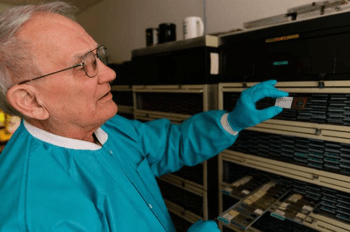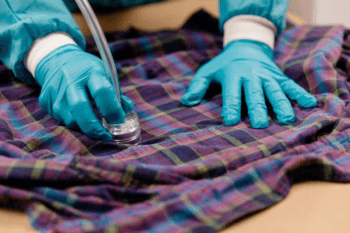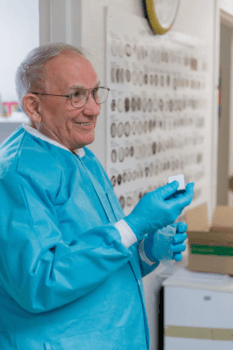Terrorism, Murder, Drug Trafficking And…Pollen?

Texas A&M Professor Dr. Vaughn Bryant’s lab takes on the personality of a beehive.
With dozens of jars of honey waiting to be tested for authenticity by Bryant, an internationally-respected palynologist, or one who studies pollen, the near constant activity in the lab that he has operated out of for 20 of his 45 years as an anthropology professor at Texas A&M makes his lab resemble exactly that: a beehive. The playful art on honey jar labels is always being inspected by his graduate and undergraduate students. Someone always seems to be popping in and out of a small room to inspect a slide from a cabinet containing one of the world’s largest collections of modern pollen reference samples – more than 20,000 in all. With an ear-to-ear smile always on his face, Bryant finds a minute or two to share a laugh with a passerby.
The chipper lab atmosphere that most visibly revolves around something as sweet as honey is a stark contrast to the solemn and austere line of work Bryant has taken up in the latter portion of his career. Lately, Bryant has been a valuable resource in assisting federal law enforcement agencies with forensics work to fight illegal drug trafficking, hunt terrorists and solve cold case murders – all using trapped pollen grains as evidence.
“To do forensics you really have to know what you’re doing or you can make some really bad mistakes,” Bryant said. “For example the pollen from marijuana plants and hackberry trees looks nearly identical, so you have to be careful not to let drug dealers go or convict innocent people.”

Luckily, for the agencies who have sought Bryant’s expertise, his analyses have positive outcomes.
After making a name for himself verifying the authenticity of honey during the 1970s by analyzing its pollen profile for a USDA loan subsidy program, another federal agency came calling after the September 11 terrorist attacks. Bryant agreed to the government’s offer and soon began examining samples such as pieces of concrete block, articles of clothing, car air filters and debris from IED materials to assist the government in tracking down terrorists. Fortunately, the trapped pollen from samples could be used to track down where the items originated.
“I did that for 10 years until they caught [Osama] bin Laden,” Bryant said. “Then all of a sudden they didn’t need me anymore.”
Still, Bryant kept busy. He recently helped identify a teenage girl who was found dead in a western New York cornfield in 1979 by tracking the origin of the pollen on her clothes back to probably San Diego or Southern Florida. After 35 years known only as “Caledonia Jane Doe,” named after the town in which she was found, authorities were eventually able to identify her in 2015 as Tammy Jo Alexander from Southern Florida.

The federal government came calling once again in 2010, this time to combat drug trafficking along the U.S.-Mexico border. He helped when he could, but the government wanted someone to help them analyze pollen full-time. He agreed to train a Texas A&M graduate, Dr. Andrew Laurence to do the job. Today, as the lead palynologist of U.S. Customs and Border Protection, Laurence is the only person in the United States analyzing pollen for forensic purposes full-time. Laurence, like Bryant, is also helping to crack cold cases by studying pollen through his work on the “Baby Doe” mystery. Bryant still helps and remains an important resource for Laurence.
With all of the possibilities forensic palynology presents in solving crimes, solving cold cases, combatting drug trafficking and helping to fight terrorism, it should be a widely-used forensic practice in the U.S., but it is not. Many law enforcement personnel are unfamiliar with pollen forensics. That combined with a lack of funding and a near total absence of scientists trained in the technique, makes it rarely used in the U.S. Today, the world leaders in using forensic pollen are New Zealand and the United Kingdom.
Although pollen forensics and CSI may seem more grandiose and exciting than analyzing honey, both are still key research areas for Bryant and his graduate students.
“If I had not done the honey studies first, I would never have been able to do the forensics,” Bryant said. “It was the decades of searching for the identity of pollen in honey samples from all over the world that basically gave me the knowledge and background to do the forensics.”
Media contact: Sam Peshek, Texas A&M Division of Marketing & Communications.





